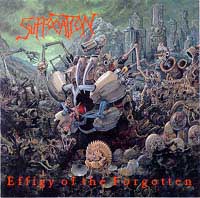Suffocation - Effigy of the Forgotten
Review: In one of the most intense incarnations of death metal Suffocation take the rhythmic relentlessness of hardcore beats and put them into speed metal structures expanded with the complexity of techno and hip-hop breakbeats and overlaid, counterpoint structures. All in its own conception, this release takes the multiple languages of music and unifies them in a surprisingly simple but evocative thundering chorus of death metal.
New York style metal takes the percussion edge of hardcore and power metal and adds it into the muffled-strum muted chordblast of older style death metal bands and simpler speed metal acts. With the deep-throated chalky rant of vocals synchronized to the offbeats of strobing, violent, cyclic riffs, the main feature of this style is the ritualistic marching beats of its verses and the blasting mayhem of its choruses. Fills are expert, precision percussion nailing complex and innovative patterns to the mark for enunciation of the resolution to each ambitious and architectural phrase.
To facilitate the structural support within these complex and multidirectional riffs, Suffocation use many strum techniques with fast scale patterns to hold riffs in place and then slide them into the omnipotent rhythms. Like thrash, each song starts on a simple contrarian rhythm and works it through its positions until concluding with an iteration of its power; like speed metal, each song follows a narrative structure with frequent variations and modulations of idea; like death metal it is architecture of correlated intricacy from the notes of every riff to the subliminal rhythms behind the erratic, epileptic, insectoid guitar solos.
For death metal at the time this release demonstrated the future of iterated percussive interpretation of song themes, and pointed toward future use of rhythm where death and grind's monotonous tonal structures had become limited as containers. Its innovation and spirit have earned it a place among the classics as an undisputed invention and advancement to the genre.
